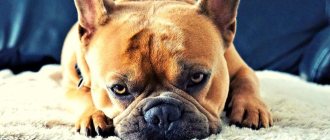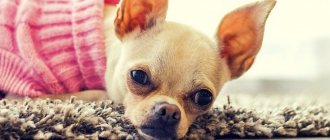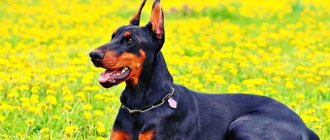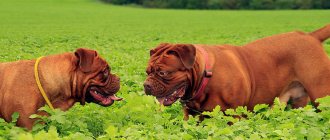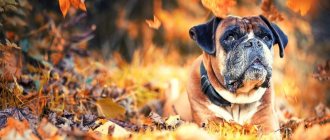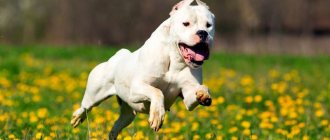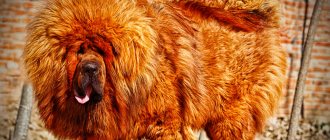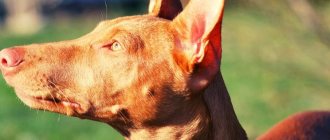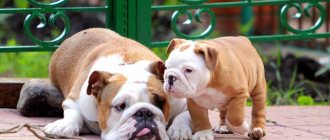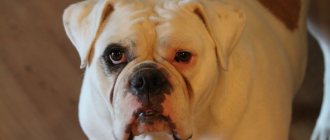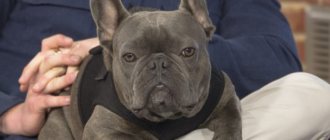Description
Bulldog smiles
English bulldogs, along with Dalmatians and retrievers, are considered one of the most easily recognizable breeds. A distinct characteristic of this breed is its short legs and large muzzle.
— Advertising —
English bulldogs have a distinctive look. Their heads are large and round, and their muzzles are flat. Individuals have a third eyelid. Dogs have large, wide-set jaws, which makes their bite force significant. Dogs have an overbite, causing their lower teeth to stick out above their upper teeth. The animals have a short and thick body, with broad shoulders and stocky legs. The pets' tail sticks up.
They come in a variety of colors, although the most common are white and brown. Characteristics of the English Bulldog species are presented below.
- Blue or blue English bulldog. This is a variation of the traditional dog, which differs in the color of its coat. Blue English Bulldogs have a mixture of gray and white coloring.
- British Bulldog. These are the standard English Bulldogs that you see most of the time on the street and in pictures. They are brown and white in color, with dark brown eyes.
- Mini bulldog, or "dwarf". This is a variety of the breed that is much smaller in size and has less wrinkled cheeks and a plump build.
English Bulldog Standard
English bulldogs are medium in size. The breed belongs to the mastiff group, a group of Molossians. The physique is compact, powerful muscles. According to the standard, height at the withers does not exceed 40 cm, and weight does not exceed 25 kg. And female English bulldogs are generally small: they weigh up to 20 kg and are 36 cm tall.
These dogs have an unusual, memorable appearance. When describing its features, one can note a large, wide head, an upturned short nose, and an abundance of folds in the skin. English bulldogs are short-haired dogs and belong to the brachycephalic breed. Due to the unusual structure of the muzzle and drooping cheeks, they look menacing and even intimidating. But some people consider this dog’s appearance to be cute. And when she opens her mouth, it seems that she is smiling.
Head Features
The head is quite large, wide, and square in format. The forehead is flat, wide, with a distinct furrow running along it from the stop. The muzzle is short, wide and flat. There are pronounced folds on the forehead, bridge of the nose and cheeks. The nose is upturned, the lobe is wide, always black, surrounded by folds.
The English Bulldog's eyes are set low, in line with the stop. Set wide apart, neither convex nor sunken. Eye color is dark, blue is not allowed, round shape.
The jaw is massive and square. The teeth are large, even, and do not protrude, but this breed is characterized by an undershot. When viewed from the side, it seems that the lower jaw protrudes forward, and the upper one seems to sink. The lips are thick, fleshy, black. The jowls hang down strongly, completely covering the sides of the jaws.
The English Bulldog's ears are set high. Located far from the eyes. The ears are small, thin, and rose-shaped. This is how triangular ears are characterized, the tips of which are lowered, slightly turned to the sides and back.
Body type
The neck is of medium length, thick and powerful, slightly convex. The nape line is clearly defined. The skin hangs down in front, and there are large folds at the withers. The topline from the withers drops slightly, then rises again, forming an arch. The chest is deep, rounded at the sides, the stomach is tucked.
The back is short, the loin is rounded, narrow. The English Bulldog's tail is set low. Thick at the base, narrows towards the end and bends downwards. The tail is short in length, no more than 8 cm, does not rise above the back, and is pressed to the body.
Limbs
The limbs are thick and muscular. The front ones are widely spaced and shorter. Due to the rounded chest, their outer line appears curved. But they are straight and parallel. The shoulders are powerful, wide, the elbows are low.
The hind limbs are longer than the forelimbs. They are also thick and powerful. The hock joints are set low, the knees are rounded, slightly turned outward. The paws are compact, the toes are large and straight.
A characteristic feature of the English Bulldog breed is its gait. They move on their fingertips in short, quick steps. The shoulders move forward when walking. The hind limbs do not rise high, but “shuffle” along the ground.
The images complement the description of the appearance of these dogs:
White English Bulldog
English bulldog at the dacha
Appearance of an English Bulldog
Coat and color
The English Bulldog is a short-haired dog. The coat is smooth, delicate, lies tightly, has a velvety structure, not wavy. There is no undercoat, the length of the guard hair is no more than 1.5 cm. The skin is thick and lies loosely. Forms many folds throughout the body.
Several colors of English bulldogs are allowed:
- all shades of red:
- red brindle and other brindle colors;
- red and white;
- brown-yellow;
- pure white;
- deer;
- piebald;
- smut - any solid color with a mask on the face, like a muzzle.
Preference is given to the traditional brindle color. Colors should be bright and saturated. If there are stains, they should be evenly distributed. Black color is not recognized as a standard; it is allowed only in the form of spots. Disqualifying defects also include blue and brown. With a solid color, the chest and belly of the English Bulldog are usually white.
English bulldog photo:
White head of an English bulldog
English bulldog muzzle
Color red and white
Varieties
In addition to the English Bulldog, there are two more varieties that are registered as separate breeds. They are similar in appearance, but there are slight differences. The American Bulldog was bred to help on the farm, protect property, and hunt. It is larger in size, harmoniously built, weighs 50-58 kg. Folds are only on the neck and muzzle, the tail is long. Ambuli are agile, hardy, but also stubborn and good-natured.
The smallest representatives of the breed were used in France to create another breed - the French bulldog. Their peculiarity is their small stature; they weigh no more than 15 kg. They have a smaller head, a less muscular build, fewer folds, and erect ears that are wide at the base. This is a decorative breed, classified as a toy. By nature, French bulldogs are more sociable, active and cheerful.
Appearance
The photo shows an adult English bulldog.
These are medium-sized dogs, but in general, their parameters are far from small. The weight of dogs depends on their age.
| Age | Weight standards, kg |
| 1 month | 2,3 |
| 3-5 months | 6,8-13,6 |
| Grown up boy | 23,6-24,9 |
| Grown up girl | 21,8-22,7 |
— Advertising —
You will have to feed puppies more often than adults. They need good nutrition due to their growth and the need to develop bone mass. Bulldogs are considered adults when they reach 18 months.
The animals are not tall, compared to other dogs. Girls and boys grow up to 31–40 centimeters in height. That's why they look short and bulky.
The dog can be of different colors and color combinations, the most common shades are:
- White
- Ginger
- Pale yellow
- brindle
- Red
- Yellow.
A dog can be “smoot” in color when its body is monochromatic and its muzzle is black. The body may contain combinations of two or three of the above colors, as well as many spots.
How to choose a puppy
Before purchasing a puppy, you should learn everything about the breed. The English are not suitable for beginners - they require competent education and training. It will be difficult for a weak-willed person to subdue a stubborn dog.
Before purchasing, it is advisable to meet the puppy’s parents in person, not from photographs. English bulldogs should move easily and freely, and not show aggression towards strangers. You should ask in advance what illnesses the animals have, whether they have “bad habits,” and what the characteristics of their temperament are. Defects not only of appearance, but also of character can be inherited.
English Bulldog puppies are very curious. They are interested in everything that happens and are not afraid of strangers. Their movements may be clumsy, but without a hint of stiffness. In healthy babies:
- shiny fur without dandruff;
- clean eyes and ears;
- white sharp teeth;
- wet and cool nose;
- a moderately well-fed body - not plump and not thin.
Well-balanced bulldog puppies respond calmly to loud noises. You can show them a new toy - the most sociable and courageous dog will approach first.
A caring breeder is always looking for the best home for their babies. He not only praises the litter, but also points out the characteristics of the breed, its pros and cons. He is interested in whether the future owner will be able to devote enough time to the pet and raise it properly.
Height and weight of English Bulldog puppies
Little Englishmen develop unevenly. This feature should not bother the owner. However, there are average standards. They help to understand whether the puppy is growing correctly and whether it exhibits any pathologies. Pets are also prone to obesity, so knowing how much a dog weighs at a given age according to the standard will help you avoid problems.
Below is a table showing the dynamics of the puppy’s weight by month.
| Age (month) | Weight, kg) |
| Newborn | 0,3-0,4 |
| 2 | 4 |
| 3 | 8 |
| 4 | 10-11 |
| 5-6 | 15-17 |
| 7-9 | 19-20 |
| 10-12 | 21-22 |
After a year, the English bulldog puppy continues to grow - it becomes more massive and strong. Formation is completely completed only by 3 years.
Pros and cons of a dog
Bulldog looking at the camera
pros
English Bulldogs are lovely pets for a relaxed family looking for another member. Apart from health concerns, they do not require much care or exercise.
Cute bulldog puppy
The animals are very loyal, making them worthy guard dogs for your home. Dogs love to socialize and relax with their owners and their children. Also, the dog does not bark or yap, so it will not interfere with rest or sleep.
Minuses
However, the breed is not for everyone. One reason: lifelong health problems. You must be prepared for this, and also be always on the alert and visit your local veterinarian on time.
A sleeping bulldog constantly snores loudly and makes noises. This may cause discomfort. Some individuals drool heavily.
Dogs are one of the most popular breeds in the world, which makes them expensive pets. You must be willing and able to invest in them throughout their lives as they get sick often. Therefore, consider your financial capabilities before choosing such a pet.
Interesting facts about the breed
People who are not familiar with the British consider them aggressive, clumsy and cruel. However, in reality this is not the case. Some interesting facts will help you better understand the breed:
- due to the peculiar structure of their muzzle, bulldogs snore;
- folds on the body are not a fun feature, but a necessity. If a dog was grabbed by the skin in battle, it still retained maneuverability and fought back the enemy;
- small bulldogs fought much better than large mastiffs. The latter were often lifted up by the bulls on their horns, while the compact Englishmen deftly grabbed their opponents by the most vulnerable spot - the nose;
- Although dogs are not great athletes, many sports teams in England use their image as a mascot. Dogs represent strength and tenacity;
- Winston Churchill never owned a bulldog, but he is compared to the breed because of his tenacity, grit and courage;
- The British are frequent heroes of books, comics, films, and cartoons.
The English Bulldog is a devoted companion, having lost the excessive aggressiveness of its ancestors. However, its fighting qualities can save the owner’s life in a dangerous situation. The main thing is to raise the puppy correctly, devote time to it and surround it with care.
History of the breed
Various English Bulldogs
The first mention of the breed appears in reports that date back to the times of the ancient Romans (31 BC to 476 BC). These works mention powerful, wide-mouthed dogs who fought alongside soldiers (Romans, Greeks and English) with great courage and valor.
The earliest written use of the name "bulldog" actually dates back to 1631 and is based on correspondence about the shipment of dogs from Spain to London.
As the name suggests, the English Bulldog breed was originally bred in England for the sport known as bullbaiting. In this medieval sport, dogs attacked and teased tethered bulls. However, bullbaiting was outlawed in 1865. It would seem that this should have been the end for the animals, but smart breeders turned the “war machine” into a friendly pet. Today, the bulldog is considered a breed that is not prone to aggression.
Socialization
Socialization of the puppy begins as early as possible. The dog must learn the rules of living in the house and get used to the environment. Later, the baby is introduced to relatives, new people and smells. It is advisable that the pet undergo a general training course (GDC).
The dog is also accustomed to other pets during puppyhood. Conflicts are possible between adults, since the English Bulldog breed is prone to dominance. However, most often the pets calmly divide the territory.
Englishmen and children get along well if the latter treat dogs with respect. The pet will not turn into a soft toy, but will become a faithful playmate. In response to excessive activity of a child, the animal will turn around and walk away rather than bite.
Maintenance and care
Two English bulldogs together in the garden
- You need to wipe the wrinkles on your pet's face every day. Use baby wipes or mild soap and a washcloth. Why does this need to be done so often? With poor care, bacteria and sweat accumulate inside the folds, causing irritation. If your pet's wrinkled skin becomes irritated, gently rub a small amount of Vaseline around the wrinkles.
- Even though it is a short-haired breed and does not shed, you will need to brush your dog several times a week. Use a soft brush or rubber comb to remove dead hair. In spring and autumn, the bulldog sheds old hairs a little more, so you will have to groom him daily or every other day. While cleaning, inspect your dog's skin for rashes, flaking, and excessive dandruff. The sooner you detect similar problems, the easier and faster it will be to cure them.
- Well-groomed animals do not need frequent bathing unless they get into something dirty. Frequent bathing can cause dry and itchy skin as it removes natural oils from the body. However, if your bulldog develops skin conditions, you will need to bathe him with special medications prescribed by your veterinarian.
- The ideal environment for a dog is a home with plenty of space. They should stay indoors most of the time and only go outside for exercise and play. Dogs do not feel well at both very high and low temperatures. The normal body temperature of a dog is 38.6℃. A higher temperature may indicate the pet is overheating.
- To walk dogs, owners purchase a harness, not a leash.
Health features and life expectancy
When keeping dogs, you must remember that bulldogs are susceptible to certain diseases:
- conjunctivitis, eversion of the eyelid, clouding of the lens;
- heart disease;
- allergy;
- dermatitis;
- dislocated elbow;
- underdeveloped genitals in males and difficult childbirth in females;
- deafness;
- urolithiasis disease;
- diseases of the nasopharynx.
To prevent the occurrence of pathologies, it is necessary to provide high-quality care, nutrition and undergo regular examinations by a veterinarian.
Important! The lifespan of English bulldogs is 14-17 years.
Nutrition
English Bulldog eats
The breed has no special dietary requirements. The only recommendation is to give your dogs high quality food. When it comes to diet, keep in mind that animals tend to be overweight. This is because they do not exercise as much as other dogs. Never overfeed your pet.
Once your pet reaches 14 to 18 months of age, you can transition him to adult food. Feed your dog twice a day. A super active dog will need about 1500 calories per day, a less active dog will need 1300 calories per day
Older bulldogs (from about 6 years of age) become less active, so it is important to feed them food that contains fewer calories. 1000 calories per day is the average for your pet. Don't forget to give them extra vitamins and minerals.
General characteristics of English bulldogs
English Bulldogs are instantly recognizable dogs. They have a remarkable appearance. A stocky build, a wide flattened muzzle and an abundance of folds in the skin are their features. At first glance, it may seem that this dog is lazy and slow. But the bulldog has a loyal heart and a courageous character. If the owner or members of his family are in danger, he will bravely rush to defense.
Breeders and breed lovers consider English bulldogs to be the most good-natured and peaceful animals. They note that they are patient, kind, loyal and smart. This is an ideal pet for families with children, for the elderly, lonely or lazy. The dog senses the owner’s mood and is able to cheer him up when he’s sad. And for a child, English bulldogs can become a nanny, protector and playmate.
The English Bulldog is an obedient and devoted pet. He is independent, balanced, self-confident, and can make his own decisions. These dogs are characterized by such qualities of a gentleman as aristocracy, equanimity, and solidity. Due to its personality traits, this dog is often used as a mascot for sports teams in the UK and USA, and is now an unofficial symbol of the Marines.
| Options | Characteristic |
| breed name | English bulldog |
| country of origin | Great Britain |
| year of breed registration | 1865 |
| group of breeds according to the ICF classification | Molossians, Pinschers and Schnauzers |
| height | 31-40 cm |
| weight | male 23-25 kg, female 18-23 kg |
| life expectancy | 8-10 years |
| character traits | equanimity, poise, courage, stubbornness |
| attitude towards a person | friendly, almost non-aggressive, does not tolerate loneliness well, gets along well with children |
| care | simple, but shedding is strong |
| need for physical activity | low, walking up to an hour a day |
| training | smart, good at responding |
| health | weak |
| purpose | companion, bodyguard, watchman, nanny |
Pros of the breed
The English Bulldog is a pet that is suitable for inexperienced owners. This is a dog for a city apartment, for calm, inactive owners. She has many advantages:
- due to its compactness, the English Bulldog is easy to keep even in a small apartment;
- This is an unpretentious pet, does not require complex care or special nutrition;
- with proper upbringing, a purebred dog will never show aggression even towards strangers or bite a person;
- the dog is calm, balanced, not vindictive, rarely loses his temper and almost never barks;
- becomes attached to children, is patient with them, can become a nanny and protector;
- At home, English bulldogs do not damage furniture, do not misbehave, and calmly wait for their owner;
- does not require long walks or heavy physical activity;
- easily get along with any pets;
- This is a good watchman and protector, despite its small size, it boldly rushes to protect its owner.
Cons of the breed
It is better not to get this dog for an active person, or for someone who is rarely at home. The English Bulldog sheds, drools and emits a specific odor, so it is also not suitable for squeamish people or those suffering from allergies. Representatives of this breed have several other disadvantages:
- due to the special structure of the nose, dogs of this breed make different sounds: gurgle, snore, sniffle, breathe noisily;
- for the same reason, they cannot endure physical activity for a long time and begin to choke;
- these dogs often suffer from increased gas formation, they have a weak stomach and increased drooling;
- they are lazy, slow, and therefore prone to obesity;
- very stubborn, do not always follow the owner’s commands;
- they constantly need to gnaw and chew something, so you need to buy a lot of toys;
- do not tolerate hot and cold weather well; in summer they need to be protected from overheating, and in winter they need to wear clothes;
- Due to the peculiarities of their anatomy, bitches cannot give birth on their own; almost all puppies are born by caesarean section.
An interesting video will tell you about the pros and cons of these dogs:
Video: English Bulldog. Pros and cons of the breed
Video: English Bulldog - an obedient, phlegmatic dog
Breeding
Bulldogs on a
bench Females are in heat, as a rule, twice a year. At this time, the dogs should be brought together and mated. On average, during pregnancy, a female bears 4 puppies, and birth occurs by caesarean section. After birth, the babies are picked up and fed by their owners. This is because the parent needs some time to recover from the surgery. Postpartum visits to the veterinarian are mandatory to ensure the health of mother and puppies.
Training and education
Gul dong (Pakistani bulldog): description of the dog breed
The characteristics of dogs show that pets show themselves as smart and self-confident animals. To raise a true gentleman, you need to train your pet from childhood.
Important! Parenting can take a long time. The person must be patient and respectful towards the dog.
They begin training by teaching him a nickname and walking on a leash. First, they master the “Nearby” command. When your pet learns to walk well in a straight line, you can practice various turns. It is also necessary to teach the “Sit” command so that the animal sits down on its own when the owner stops.
For a pet, basic commands are enough
You can reward your pet with snacks or other treats.
Puppies
Two English Bulldog puppies at home
- You should feed your baby three times a day on a schedule for the first four months. After 6 months you can start cutting back to 2 times a day.
- Regular food from the store is quite suitable for your pet. Which one is better to choose? Study the first five ingredients on the label: meats should come first, then vegetables, then grains.
- Do not feed animals human products that are toxic and harmful to their bodies. For example, chocolate, raisins, avocado, green onions, garlic and so on.
- Monitor your newborn's weight. Individuals easily gain kilograms. If your puppy is gaining weight rapidly, consult your veterinarian.
- Provide 24/7 access to clean, fresh water. This is especially important in hot or humid weather.
- Give your puppy preventative treatment for local diseases.
- Take your pet for regular veterinary checkups.
- Check your pet's ears once a week. The inside of the ear is usually white or dark in color, matching the color of the dog's coat.
- Clean and inspect your baby's feet and toes regularly to prevent interdigital furunculosis or ingrown toenails.
- Socialization is very important to ensure your puppy gets along with other dogs, animals and people. Individuals aged 14 to 16 weeks are most susceptible to socialization.
- These puppies are temperature sensitive. They often suffer from heatstroke, but also do not like the cold.
Description of the breed
Despite its good-natured appearance and apparent clumsiness, the dog has a powerful jaw and sharp teeth. The pet's skin folds are a relic of the times when the bulldog had to fight in the ring. They helped protect against flowing blood and gave the animal maneuverability. The size of the animal reaches 40 cm, and the weight of an adult dog is about 25 kg.
There is also a mini English bulldog, which was born at the beginning of the 21st century thanks to the efforts of breeders from the USA. The dwarf pet weighs no more than 15 kg, but is not inferior in character to its direct relative.
The generally accepted characteristics of the breed are as follows:
- The head is set high and has a square shape. The muzzle is flattened, the cheeks are round.
- The eyes are small, the color of the iris is dark brown. The nose is large, pigmented black. The lips are thick and wide.
- The neck is strong and thick. The chest is round and wide. The back is short, the shoulders are widely spaced.
- The paws are muscular and very strong. The tail is set low, has a rounded shape, and is thinner at the end than at the base. Does not rise higher than the back.
- The coat is short and thick, soft to the touch.
The actual color must be uniform, although a combination of colors is allowed. The most common shades:
- white;
- ginger;
- brindle;
- pale yellow;
- confusion (white color and the presence of a black mask on the face).
Black and black and tan colors are considered unacceptable according to the breed standard. Therefore, dogs whose tricolor is given out by unscrupulous breeders as an expensive exclusive, in fact have a serious disqualifying defect.
Any colors not specified in the standards are not officially recognized by the International Canine Federation. This applies to blue, brown, etc. bulldogs.
Lifespan
English Bulldog on a leash
A study conducted by the British Kennel Club and the British Small Animal Veterinary Association found that the average lifespan of the species was 8 years. At the same time, about 9% of animals died from “old age.”
Another 2010 study puts the average life expectancy at 6 years. English Bulldogs were once considered healthy dogs with an average lifespan of 10 years. But today these numbers have decreased and amount to 6-8 years.
The most common causes of death are heart disease (11.8%), cancer (10.9%) and brain disorders (9.1%), and cutaneous folding dermatitis (7.8%).
Personality of English Bulldogs
As in appearance, there is a lot of unusual in the character of this dog. The English Bulldog is the most controversial pet. These dogs are independent but loyal, lazy but always ready to play. Despite their menacing appearance, they are good-natured, affectionate and calm pets. There is nothing left in the character of the ferocious ancestors. Now the English Bulldog is distinguished by a calm, phlegmatic temperament and calm, good-natured disposition. This is a wonderful companion, a loyal friend and a reliable bodyguard.
This dog perceives its owners as its own pack. He is devoted to all family members and becomes strongly attached to them. This dog sensitively understands the owner’s mood and is able to understand him instantly. Especially loves children. An adult dog will never deliberately harm a baby, but he may accidentally push or, in a fit of emotion, jump on a child and injure him. With proper upbringing, he becomes the best friend for children and will participate in all entertainments. Moreover, his character has many childish traits: playfulness, mischief, impatience, capriciousness.
Despite the phlegmatic temperament and calm behavior, the English Bulldog is very attached to people and does not tolerate loneliness well. These dogs require a lot of attention and can become disobedient if not given enough companionship. Therefore, those who spend the whole day at work should not have them. Thanks to its friendly disposition, this dog gets along well with other pets. A bulldog will be friends with cats, dogs and even birds. But you cannot deprive him of attention, otherwise he may be offended.
One of the characteristic qualities of this dog is stubbornness and independence. Fans of the breed often respect English bulldogs for this very reason. They are smart, intelligent, but it is very difficult to force this dog to do something if it doesn’t want to. It is especially unacceptable to show aggression or violence; you need to be able to negotiate with them. This dog will never obey if you treat him roughly. One must take into account his natural thoughtfulness and slowness; one cannot scold him for being slow.
Training and education of English bulldogs
English Bulldogs are dogs that are suitable for inexperienced owners. But in education it is necessary to show persistence and patience. They are often stubborn and lazy, you need to be able to find an approach to your pet. This dog is smart, he thinks about commands before executing them.
Dog training should begin from the first weeks of life. They sell a puppy at 2-3 months, it is advisable that he already understands what he should not do. The first commands that need to be taught to your pet are “place”, “come to me”, “no”, “fu”, “sit”. Before you start taking your puppy outside, you need to accustom him to a leash and train the “heel” command. Then there will be no problems with this stubborn dog on a walk.
When training a bulldog, you should not be aggressive or rude. But the command must be given in a clear, confident voice, and always be consistent. This dog obeys only the owner who has been able to gain authority. Prohibitions must be observed by all family members; the pet should not be given any concessions. Otherwise, it will be impossible to re-educate him later. It is especially important to immediately wean the dog from sleeping in the bed, sharpening its teeth on furniture, and jumping on people.
To succeed in raising a bulldog, you need to follow a few tips:
- you need to become a friend for this dog, establish a trusting relationship;
- give commands in a calm, confident voice, complement them with gestures;
- always pronounce commands the same way;
- ensure that the dog does what is required;
- encourage correct behavior with affection and treats;
- training for puppies should be structured in the form of a game;
- you cannot hit the dog or shout at it;
- Long training is not needed, bulldogs get tired quickly.
When getting a bulldog, it is worth remembering that uncastrated males can show aggression. Therefore, early socialization is very important. It is also advisable to take a training course under the guidance of an experienced dog handler.
Interesting photos complement the characteristics of these dogs:
English bulldog playing with a stick
Sleeps sweetly...
English bulldog on a skateboard
Dog character
English bulldog puppies play on the grass.
The bulldog's temperament is calm, brave and friendly. These are confident dogs that are loyal, affectionate, and sometimes funny. Although they were bred as fighting dogs in the past, modern specimens are generally not aggressive towards people. They are friendly and loving in nature. A domestic Bulldog will be a playful, active puppy in the home. The animal sleeps next to its owner, which makes it an excellent companion.
Breed card
- Known breed names: Bulldog, British Bulldog, British Bulldog
- FCI breed number: 149
- Description of the standard on the FCI website: link
- Height at withers: 35-40 cm
- Adult dog weight: up to 35 kg
- Color options: white, fawn, brindle, fawn, spotted
- Lifespan: up to 10 years
- Puppy cost: from 15,000 to 30,000 rubles
- Size: 3 out of 5
- Learning ability: 4 out of 5
- Attitude towards children: 5 out of 5
- Shedding intensity: 2 out of 5
- Protective and guard qualities: 3 out of 5
Education
English bulldog with a ball
Many owners are interested in how to properly train bulldogs and when to start training. Puppies will follow the leader of the pack, and you must be that leader. As a leader, you must raise your child, teach him how to behave and fit into a new environment. Train your puppy to follow your commands. It is important to start parenting at an early age. Training will be most successful when you praise and reward your baby. Instead of punishing your puppy when he doesn't do the right thing, you should reward him when he does the right thing.
If you are unable to train your pet yourself, contact your local dog behaviorist.
Character
The English Bulldog is very serious in character. He is devoted to his owner and needs attention. The bulldog's respect must be earned, as the dog prefers to dominate. He requires early socialization, otherwise he may show aggression towards other animals.
The bulldog's character is unique - he tends to think.
Perfectly distinguishing the intonations of the owner, the dog will definitely think about the command before executing it. Hurrying is not in his rules. He loves to solve problems and is a wonderful companion.
The Bulldog considers himself a boss - he is very stubborn and will not give in if he does not want to obey and considers the order unworthy of attention. The English Bulldog has a stable nervous system, and he himself does not start conflicts. But, sensing a threat to the owner’s life, the bulldog will turn from a slow intellectual into a lightning-fast and decisive defender.
The dog becomes very attached to the family and changes of owners are very difficult to bear.
Diseases
Bulldog sad
- Dry eyes. Individuals often experience lacrimation. This can cause a "blue haze" to appear on the eyes, which damages vision and causes pain. To combat this problem, contact your veterinarian, who will prescribe the necessary medication.
- Sneezing. Sneezing, in most cases, is normal in both dogs and humans. Reverse sneezing, also known as an inverted sneeze, occurs when nasal fluids drip into your pet's soft palate. At this point, pets may cough and choke. This is usually not serious, so the best way for your dog to escape from you is to comfort the animal during an attack.
- Brachycephalic syndrome. With the syndrome, your pet's airways are closed. This may be due to problems in the nose or roof of the mouth. The dog is breathing with difficulty, coughing and sniffing a lot. Contact a specialist immediately.
- Shakes his head. Your animal will begin to shake its head up and down or from side to side for no apparent reason, and a slight tremors will appear. This is caused by stress as well as low blood sugar. Give your pet a spoonful of honey. If this doesn't help, contact your veterinarian.
- Hip dysplasia. Hip dysplasia is an inherited disease. In this problem, the femur does not fit tightly into the hip joint, causing it to move abnormally. Most English Bulldogs have hip dysplasia based on their natural build. Therefore, consult a specialist for a diagnosis.
- Allergy. Animals may be allergic to certain foods, chemicals and other irritants. The dog develops rashes and hair falls out. Contact a specialist who can help identify the cause.
Typical diseases of this breed
Bulldogs suffer from heart disease - mitral valve disease is common, manifested by shortness of breath, coughing and rapid fatigue of the dog.
The second known problem is obesity due to the dog’s low mobility and passion for tasty food. Poor quality food can cause urolithiasis.
Hereditary diseases typical of bulldogs:
- third eyelid adenoma;
- conjunctivitis;
- dermatitis and irritation;
- acne;
- brachycephalic syndrome;
- joint dysplasia.
In addition to those indicated, cancer and allergic reactions are quite common.
English Bulldog (breed history, photo, character, choice of puppy
Interesting Facts
Bulldog tore a tennis ball
- Many US presidents have owned pets during their time in the White House, but only one of them had an English bulldog. This was the 29th President of America, Warren Harding.
- More than 80 percent of bulldogs are born by cesarean section. This is due to the size of the head, which prevents the natural birth of babies.
- Many celebrities have this look, including Leonardo DiCaprio, Reese Witherspoon, David Beckham, Ashley Olsen, Hugh Jackman, Zac Efron and Martha Stewart.
- Animals suffer greatly during flights due to problems with breathing and heat regulation. Because of this, many airlines prohibit flying with these dogs.
- A special feature of the breed is that old English bulldogs can jump up to 200 centimeters in the air.
- The species is one of the most common school mascots in America. Nearly 40 universities across the country name their sports teams after the Bulldogs.
- In England, animals are considered a national breed. World War II propaganda portrayed the country as a tough-looking bulldog. Germany was then represented by the dachshund, and the United States was represented by the American pit bull. Winston Churchill was called the “British Bulldog” due to his behavior, and perhaps his appearance.
- Otto the Skateboarding Dog broke the Guinness World Record in 2015 for the Longest Tunnel Compassed by a Dog on a Skateboard. Photos of the dog are presented below.
- One owner from Cleveland, Ohio, USA, reported that his dog Oliver had a lifespan of 20 years.
- The Staffordshire Bull Terrier is a cross between an English Bulldog and a Terrier.
History of the origin of the English Bulldog breed
English bulldogs are one of the national breeds of Great Britain. It appeared in its modern form in the 19th century. It was bred on the basis of the Old English bulldogs, which were common in England since the 17th century. They were used for dog fighting, which is reflected in the name of the breed. Bulldog is translated as “bull dog”.
At that time, representatives of the breed were angry and aggressive. They were set against bulls, bears, and used for hunting wild boars and deer. Features of appearance are associated with this. The powerful jaws had a death grip, and the skin with a large number of folds made the dog maneuverable. The blood flowing down the folds of the muzzle did not flood the eyes. This, as well as their insensitivity to pain, made bulldogs better fighters. But in the middle of the 19th century, the English government banned dog fighting. The breed was brought to the brink of destruction, as it was no longer adapted to anything.
Lovers set a goal to preserve its characteristics, but eradicate anger and aggressiveness. The most peaceful and calm individuals were selected throughout the country. The appearance has changed slightly: the paws have become shorter, the muzzle has become wider, and there are more skin folds. Already in 1873, the breed was presented to the kennel club in a new form and officially recognized. Since the end of the 19th century, the English bulldog began to spread to other countries.
These dogs are loved for their unusual appearance and calm, balanced character. Now this is one of the most popular decorative breeds, characterized by its good nature and peace-loving nature. All they have left from their ancestors is a formidable appearance.
Care
English bulldogs are adapted for living in apartments and private homes. They require daily but not very long walks, socialization and information loads. These dogs are contraindicated for long-term active physical exercise, as well as exposure to the sun and stuffy rooms.
In cool weather, English Bulldogs are advised to wear overalls.
Grooming is not difficult. Washing when dirty, wiping the coat with wet wipes and combing out with a brush. It is necessary to keep your eyes and ears clean. Regularly wipe the skin folds on the head.
Character and habits
The English Bulldog is a homebody with a calm temperament and balanced character. Dogs of this breed are smart, easy to train, active, but at the same time they are often lazy and love to sleep. English Bulldogs are fearless and unwavering, difficult to frighten, and have a sense of self-respect and typical English reserve. They are distinguished by tenacity, sometimes bordering on stubbornness. Bulldogs are favorites of the whole family, including children. They are incredibly loyal to their owner and are very sad when separated from him. Dogs of this breed require reasonable training and a supply of chew toys; they love to chew on various objects.
